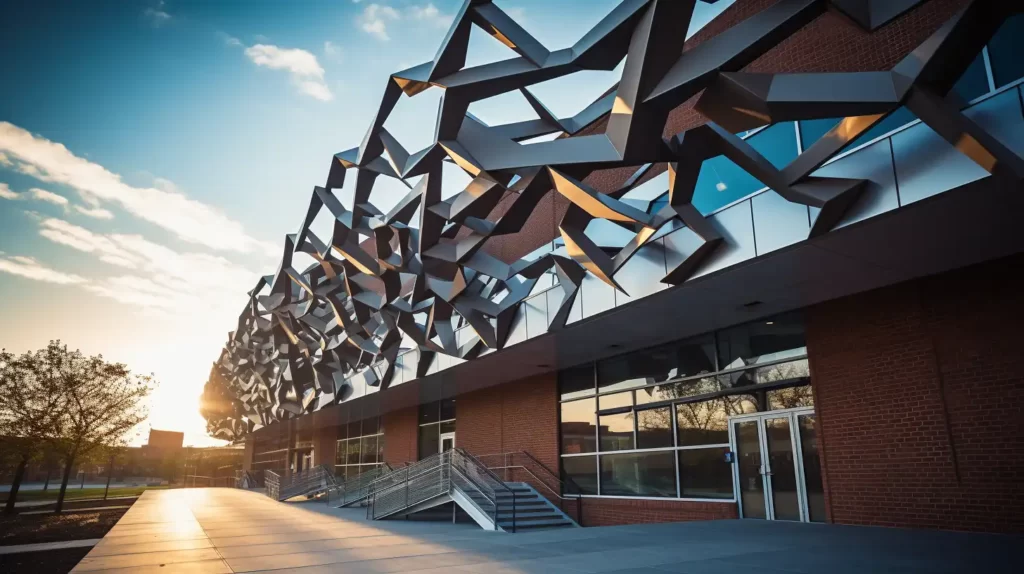The allure of modern cities often lies in their stunning landscapes and innovative structures. A key player in crafting these mesmerizing urban environments is architectural metal fabrication for urban design. This intricate process not only transforms raw metals into stunning architectural pieces but also significantly enhances the aesthetic and functional aspects of urban spaces.
In the bustling realm of urban design, architectural metal fabrication serves as a cornerstone for creating unique and durable structures. Whether it’s the sleek lines of a skyscraper or the ornate details of a public art installation, metal fabrication plays a crucial role in shaping the cities of tomorrow. Let’s delve deeper into this fascinating world and explore its impact on urban design.

The Importance of Metal Fabrication in Urban Design
Metal fabrication is essential in urban design due to its versatility, strength, and aesthetic appeal. It allows architects and designers to create structures that are not only visually appealing but also robust and long-lasting. This is crucial in urban environments where structures face constant exposure to the elements and high levels of wear and tear.
Enhancing Aesthetics with Metal
One of the primary reasons metal is favored in urban design is its ability to enhance aesthetics. Metals like steel, aluminum, and copper can be molded into various shapes and finishes, providing endless possibilities for creative expression. For more insights on how modern designs incorporate metal, visit modern architectural metal designs.
Durability and Functionality
Beyond aesthetics, the durability and functionality of metal make it an indispensable material in urban design. Structures must withstand harsh weather conditions, and metals offer the resilience needed to ensure longevity. Furthermore, metal fabrication allows for precision and customization, ensuring that each structure meets specific functional requirements.
Key Processes in Architectural Metal Fabrication
Metal fabrication involves several critical processes, each contributing to the final product’s quality and functionality. These processes include cutting, bending, welding, and finishing.
Cutting and Shaping
Cutting is the first step in metal fabrication, where raw metal is cut into desired shapes and sizes. This process requires precision and expertise to ensure accuracy. For more on precision techniques, explore low-volume precision cutting.
Bending and Forming
After cutting, the metal is bent and formed into the required shapes. This process is crucial for creating complex structures that fit seamlessly into urban designs.
Welding and Assembly
Welding joins different metal pieces together, forming a cohesive structure. This step requires skilled artisans to ensure strong and flawless connections.
Finishing Touches
The final step in metal fabrication involves applying finishes that enhance the metal’s appearance and protect it from corrosion. For tips on maintaining these finishes, visit how to maintain architectural metal finishes.
Applications of Metal Fabrication in Urban Design
Architectural metal fabrication finds applications in various aspects of urban design, from infrastructure development to decorative art installations.
Building Facades
Metal is extensively used in building facades due to its ability to create striking visual effects and its resilience against environmental factors.
Bridges and Overpasses
Metal’s strength makes it ideal for constructing bridges and overpasses, which require materials that can support heavy loads and endure constant use.
Public Art Installations
Artists and designers frequently use metal to create public art installations that add character and vibrancy to urban spaces.
Choosing the Right Metal Fabricator
Selecting the right metal fabricator is crucial for the success of any urban design project. Factors to consider include experience, expertise, and reputation. For guidance on selecting a fabricator, refer to how to choose an architectural metal fabricator.
Experience and Expertise
An experienced fabricator can offer valuable insights and solutions, ensuring that the project meets the highest standards of quality and innovation.
Reputation and Reliability
A reliable fabricator will have a strong track record of successful projects and satisfied clients, providing peace of mind and assurance of quality work.
Future Trends in Metal Fabrication for Urban Design
The future of metal fabrication in urban design is promising, with advancements in technology and materials driving innovation.
Sustainable Practices
As environmental concerns grow, there is a push towards sustainable practices in metal fabrication. This includes using recycled materials and adopting energy-efficient processes.
Technological Innovations
Technological advancements, such as 3D printing and robotic fabrication, are set to revolutionize the field, offering new possibilities for creativity and efficiency.
Conclusion
Architectural metal fabrication plays a vital role in shaping the urban landscapes of today and tomorrow. Its versatility, strength, and aesthetic appeal make it an essential component of urban design. As technology continues to evolve, the possibilities for innovation in metal fabrication are endless, promising exciting developments for the future.

Frequently Asked Questions
What is architectural metal fabrication?
Architectural metal fabrication is the process of transforming raw metals into finished products used in construction and design. It involves cutting, bending, welding, and finishing to create structures that are both functional and aesthetically pleasing.
Why is metal important in urban design?
Metal is crucial in urban design due to its durability, versatility, and aesthetic appeal. It allows for the creation of structures that are strong, long-lasting, and visually striking.
How can I choose a reliable metal fabricator?
When choosing a metal fabricator, consider their experience, expertise, and reputation. Look for fabricators with a proven track record of successful projects and satisfied clients.
This article contains affiliate links. We may earn a commission at no extra cost to you.

